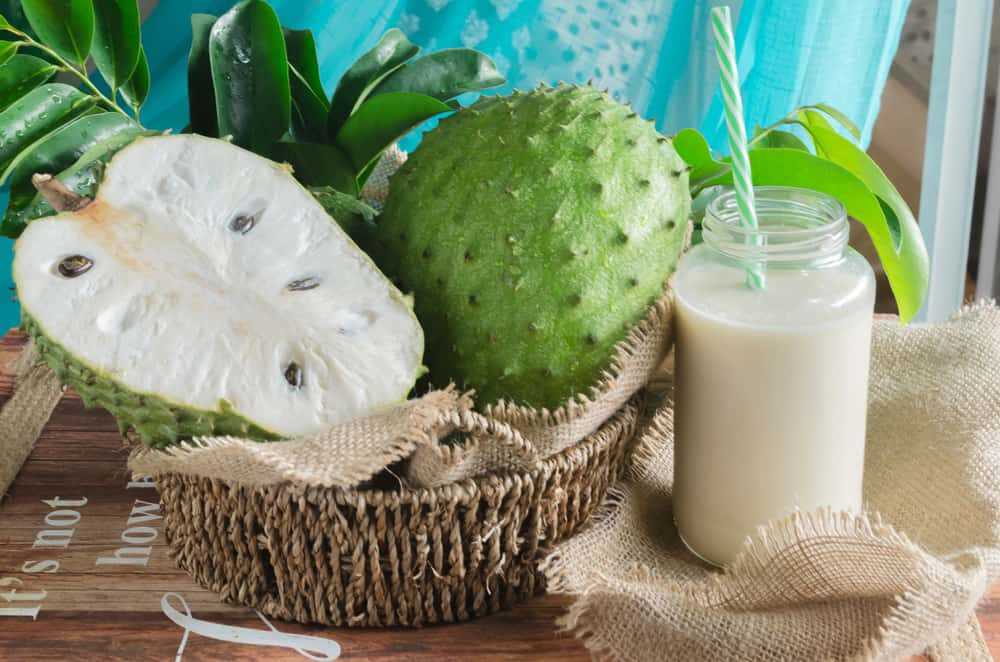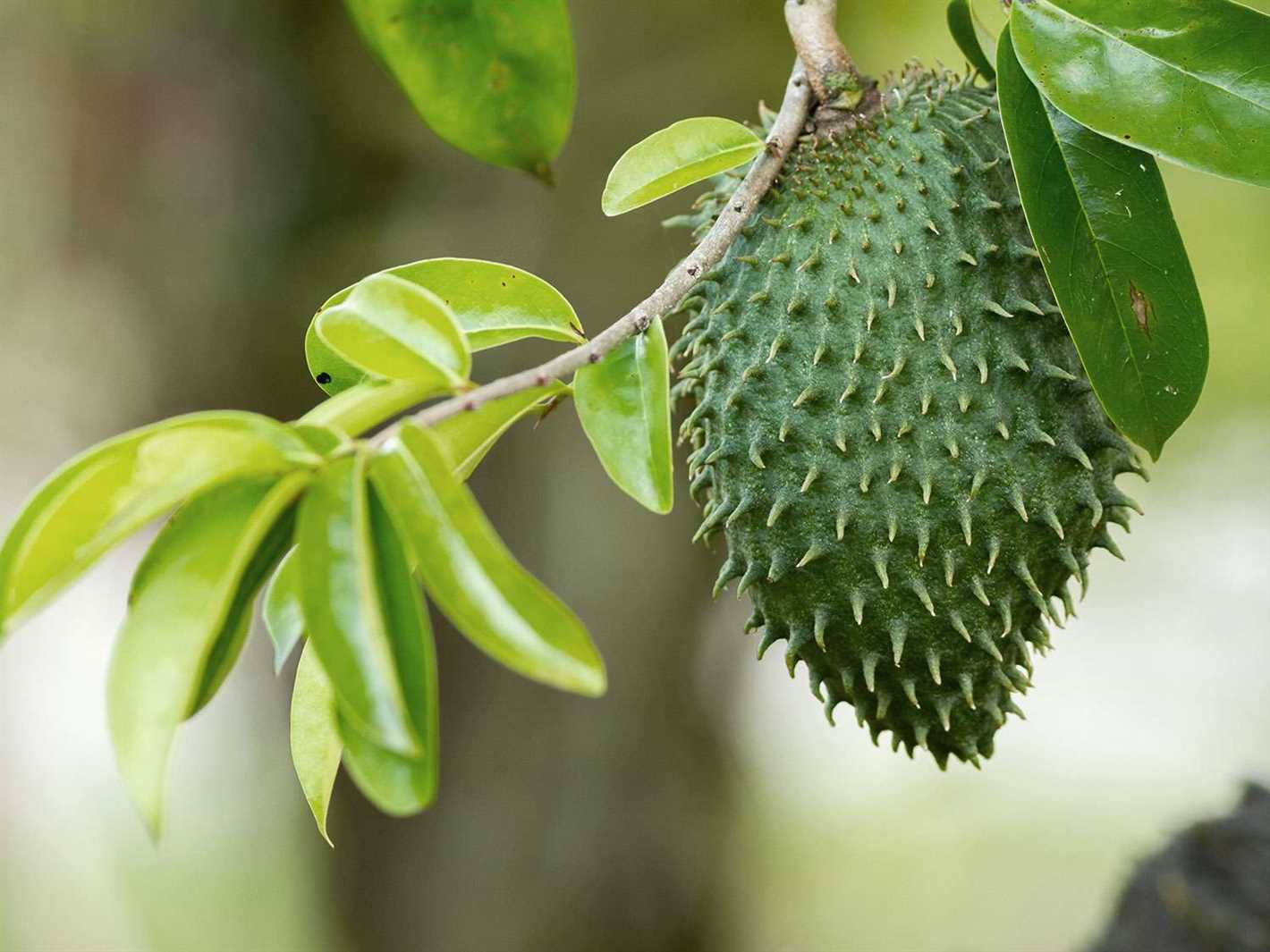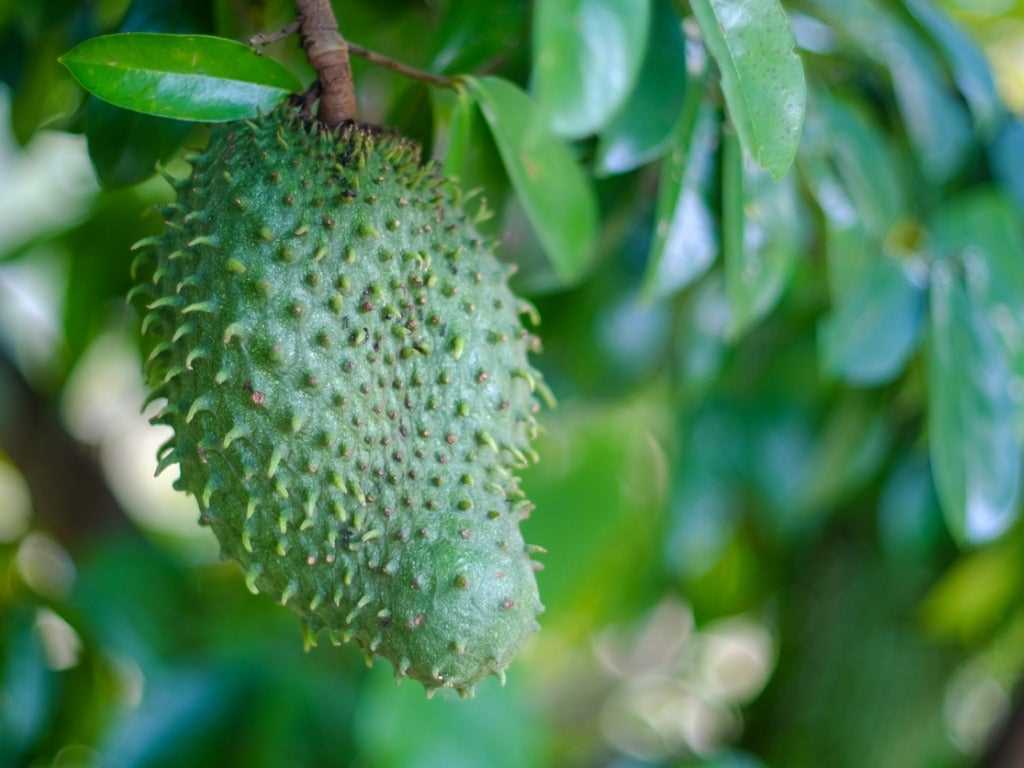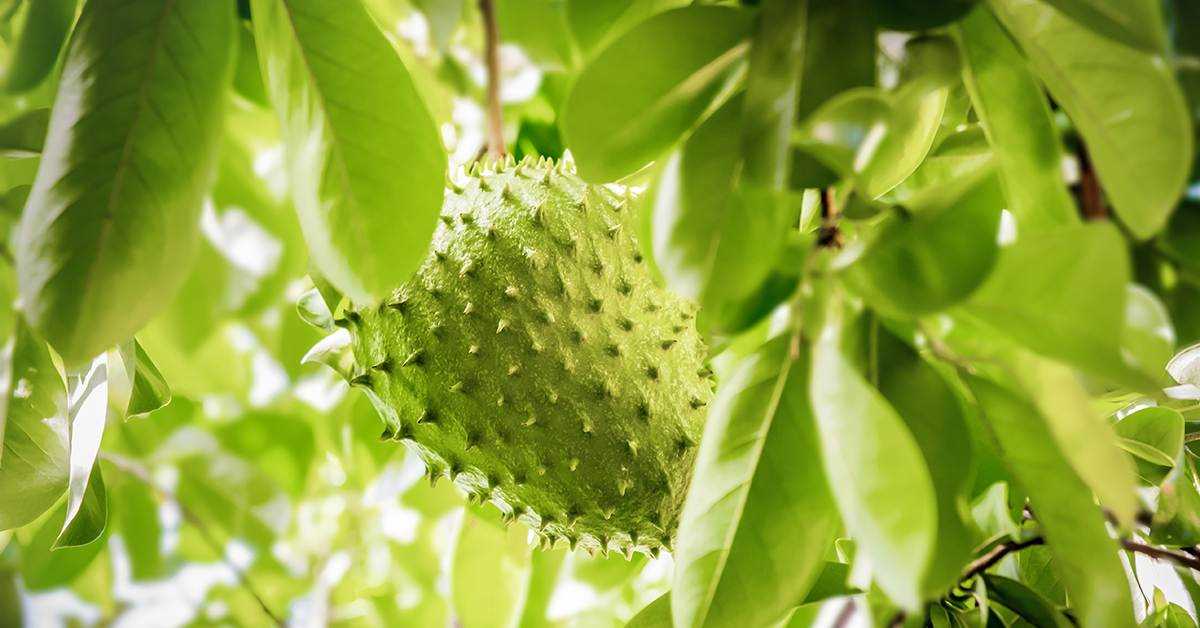- Soursop: Comprehensive Care Guide, Types, and Varieties
- Caring for Your Soursop Tree
- Types and Varieties of Soursop
- In Conclusion
- Benefits of Soursop
- 1. Immune system booster
- 2. Anti-cancer properties
- 3. Digestive health
- 4. Anti-inflammatory effects
- 5. Heart health
- 6. Skin health
- 7. Weight management
- 8. Rich in vitamins and minerals
- Best Practices for Growing Soursop
- Common Problems and Solutions
- 1. Pests and Diseases
- 2. Fruit Drop
- 3. Lack of Flowering
- 4. Poor Fruit Quality
- 5. Nutrient Deficiencies
- Different Types of Soursop
- Giant Soursop
- Green Soursop
- Red Soursop
- Spiny Soursop
- Varieties of Soursop
- Giant Soursop
- Thornless Soursop
- Red Soursop
- Spiny Soursop
- Peruvian Soursop
- West Indian Soursop
- Mexican Soursop
- Soursop Recipes and Culinary Uses
- 1. Soursop Smoothie
- 2. Soursop Sorbet
- 3. Soursop Juice
- 4. Soursop Curry
- Q&A:
- What is soursop and how do I take care of it?
- What are the different types of soursop?
- Can soursop be grown in a pot?
- How long does it take for a soursop tree to bear fruit?
- What are some common pests and diseases that affect soursop trees?
- How do I know when a soursop fruit is ripe?
- Can soursop be used for medicinal purposes?
- Video: How to make Soursop Tea (Where to Buy? What’s the Benefits?)
Are you a fan of exotic fruits and looking to explore new flavors? Look no further than soursop! Soursop, also known as graviola, is a tropical fruit native to the Americas. Its unique taste, creamy texture, and numerous health benefits make it a popular choice among fruit enthusiasts.
But what exactly is soursop? Soursop is a large, green fruit with thorny skin and a custard-like flesh. It is known for its tangy, sweet, and slightly acidic flavor. The fruit is often used in desserts, beverages, and even as a natural remedy for various ailments.
There are several types and varieties of soursop available, each with its own distinct characteristics. The most common types include the Brazilian pawpaw, Cuban soursop, and Mexican soursop. Some varieties have a sweeter taste, while others have a more acidic flavor.
In this comprehensive care guide, we will explore everything you need to know about soursop, from its cultivation and harvesting to its health benefits and culinary uses. Whether you’re a seasoned soursop lover or new to this tropical fruit, this guide will help you make the most of your soursop experience.
“Soursop: a tropical delight that tantalizes the taste buds and nourishes the body.”
Join us as we dive into the world of soursop and discover why this unique fruit continues to captivate people worldwide.
Soursop: Comprehensive Care Guide, Types, and Varieties
Soursop is a tropical fruit native to the Caribbean, Central America, and South America. It is known for its unique taste and numerous health benefits. If you are planning to grow soursop or already have a soursop tree, this comprehensive care guide will help you ensure its healthy growth and maximize fruit production.
Caring for Your Soursop Tree
1. Location: Soursop trees thrive in tropical climates with temperatures between 70°F and 85°F. They require full sun exposure to grow and produce fruits. Choose a location with well-drained soil and protection from strong winds.
2. Watering: Soursop trees need regular watering, especially during dry periods. Water the tree deeply, allowing the soil to absorb the water. However, make sure not to overwater, as soursop trees are sensitive to waterlogged conditions.
3. Fertilizing: Soursop trees benefit from regular fertilization. Use a balanced fertilizer with a higher potassium content to promote healthy fruit development. Apply the fertilizer every 2-3 months during the growing season.
4. Pruning: Prune your soursop tree to maintain its size and shape, as well as to promote air circulation and sunlight penetration. Remove any dead or diseased branches, and trim back excessive growth to encourage fruiting.
Types and Varieties of Soursop
1. Cuban Soursop: This variety is known for its large fruit size and sweet flavor. It has a smooth green skin and white pulp with a creamy texture.
2. Brazilian Soursop: Brazilian soursop is highly prized for its aromatic flavor and high sugar content. The fruit is medium-sized and has a spiky green skin.
3. Mexican Soursop: Mexican soursop is characterized by its small to medium-sized fruit and slightly acidic taste. It has a knobby green skin and white pulp.
4. West Indian Soursop: This is the most common variety of soursop and is widely cultivated for commercial purposes. It has a large fruit size, green skin with spines, and white juicy pulp.
In Conclusion
Growing soursop can be a rewarding experience, both in terms of taste and health benefits. By following the care guide mentioned above and choosing the right soursop variety for your taste preferences, you can enjoy this tropical fruit right from your own backyard.
Benefits of Soursop
1. Immune system booster
Soursop is rich in antioxidants, which help to strengthen the immune system and protect the body against harmful free radicals. The fruit is also packed with vitamin C, which is known to increase the production of white blood cells and thus improve the body’s ability to fight off infections.
2. Anti-cancer properties

Studies have shown that soursop contains compounds that have anti-cancer properties and may help prevent the growth of cancer cells. These compounds have been found to be particularly effective against breast, colon, prostate, and lung cancers.
3. Digestive health

Soursop is rich in dietary fiber, which helps to promote healthy digestion and prevent constipation. It also contains natural compounds that have been found to help relieve digestive issues such as stomach ulcers, indigestion, and acid reflux.
4. Anti-inflammatory effects
The active compounds present in soursop have been found to have anti-inflammatory effects, which can help reduce inflammation in the body. This can be particularly beneficial for individuals suffering from conditions such as arthritis, gout, and other inflammatory diseases.
5. Heart health
Soursop contains several nutrients that are beneficial for heart health, including potassium, fiber, and antioxidants. These nutrients help to regulate blood pressure, lower cholesterol levels, and reduce the risk of cardiovascular diseases.
6. Skin health
The antioxidants present in soursop can help protect the skin from damage caused by free radicals and environmental factors. Regular consumption of soursop can help improve skin health, reduce the appearance of wrinkles, and promote a youthful complexion.
7. Weight management
Soursop is low in calories and high in fiber, making it a great addition to a weight loss diet. The fiber helps to promote feelings of fullness and reduce cravings, while the low caloric content makes it an ideal snack for those watching their weight.
8. Rich in vitamins and minerals
Soursop is a good source of several essential vitamins and minerals, including vitamin C, vitamin B6, thiamin, riboflavin, folate, magnesium, and potassium. These nutrients are important for maintaining overall health and well-being.
Overall, soursop is a versatile fruit that offers numerous health benefits. Whether you consume it in its natural form, as a juice, or as a supplement, adding soursop to your diet can improve your overall health and well-being.
Best Practices for Growing Soursop
- Choose the right location: Soursop trees thrive in tropical and subtropical climates. They prefer full sun and well-drained soil. Select a location that receives direct sunlight for at least 6 to 8 hours a day.
- Prepare the soil: Soursop trees can tolerate a range of soil types but perform best in slightly acidic soil with a pH level of 6 to 6.5. Before planting, loosen the soil and remove any weeds or grass. Add organic matter such as compost or aged manure to improve soil fertility and drainage.
- Planting: Dig a hole that is twice as wide and deep as the root ball of the soursop plant. Place the plant in the hole, ensuring that the top of the root ball is level with the soil surface. Backfill the hole with soil and gently firm it around the plant. Water thoroughly.
- Watering: Soursop trees have moderate water needs. Water the plant deeply once a week, allowing the soil to dry out between waterings. During hot and dry periods, increase the frequency of watering.
- Fertilization: Fertilize the soursop tree regularly to promote healthy growth and fruit production. Use a balanced fertilizer with a ratio of 10-10-10 or similar. Apply the fertilizer according to the package instructions, usually every 2 to 3 months during the growing season.
- Pruning: Pruning helps maintain the shape and size of the soursop tree and improves air circulation. Remove dead or damaged branches and any suckers that emerge from the base of the tree. Prune in late winter or early spring before new growth emerges.
- Pest and disease control: Soursop trees are generally resistant to pests but can be susceptible to some diseases, such as fruit rot or black spot. Monitor the tree regularly for any signs of pests or diseases and take appropriate action, such as applying organic or chemical treatments.
- Harvesting: Soursop fruits are ready for harvest when they are slightly soft to the touch and have a yellowish-green color. Cut the fruit from the tree using a sharp knife or pruning shears, leaving a small stem attached. Handle the fruits with care to avoid bruising.
- Storage: Soursop fruits are best consumed fresh, but they can be stored in a cool and dry place for a few days. For longer storage, the fruits can be frozen or made into juices, jams, or other products.
Common Problems and Solutions
1. Pests and Diseases
Soursop trees are susceptible to various pests and diseases that can affect their growth and overall health. Some common pests that may attack soursop trees include aphids, mealybugs, and fruit flies. Additionally, diseases such as anthracnose, powdery mildew, and stem canker can also be problematic for soursop trees.
To mitigate these issues, it is important to regularly inspect the trees for any signs of pests or diseases. Implementing cultural practices like regular pruning, proper sanitation, and removing fallen leaves can help prevent the spread of diseases. In cases of severe infestation, organic or chemical treatments may be necessary.
2. Fruit Drop
Soursop trees may experience fruit drop, where the fruits prematurely fall from the tree before they are fully ripe. This can be caused by various factors such as improper pollination, insufficient nutrients, or environmental stress.
To prevent fruit drop, ensure that the trees are properly pollinated, either naturally through the presence of pollinators or by hand-pollination. Adequate fertilization and irrigation are also important to provide the necessary nutrients and moisture for fruit development. Additionally, protecting the trees from extreme weather conditions and providing appropriate shade can help minimize environmental stress.
3. Lack of Flowering
In some cases, soursop trees may fail to produce flowers, which is necessary for fruit formation. This can be attributed to factors such as improper pruning, nutrient deficiencies, or insufficient sunlight.
To encourage flowering, it is important to maintain proper pruning practices, ensuring that the trees are not over-pruned. Providing the trees with a balanced fertilizer containing essential nutrients like potassium, phosphorus, and nitrogen can also promote flowering. Additionally, ensuring that the trees receive adequate sunlight, ideally at least 6 hours of direct sunlight per day, can help stimulate flower production.
4. Poor Fruit Quality
If soursop fruits are of poor quality, it could be a result of factors such as improper harvesting, inadequate pollination, or nutrient deficiencies.
To ensure good fruit quality, it is important to harvest the fruits when they are fully ripe. This can be determined by the fruit’s texture and color. Additionally, ensuring proper pollination by providing access to pollinators or hand-pollinating can improve fruit quality. Regularly fertilizing the trees with a balanced fertilizer and addressing any nutrient deficiencies can also contribute to better fruit quality.
5. Nutrient Deficiencies

Soursop trees can suffer from nutrient deficiencies, which can manifest as yellowing leaves, stunted growth, or poor fruit development. Common nutrient deficiencies in soursop trees include nitrogen, phosphorus, potassium, iron, and magnesium.
To address nutrient deficiencies, it is important to conduct a soil test to determine the specific nutrient deficiencies. Based on the results, appropriate organic or chemical fertilizers can be applied to correct the deficiencies. Additionally, incorporating organic matter into the soil can help improve its nutrient content and overall health.
Different Types of Soursop
Soursop is a tropical fruit that comes in several different varieties. Each type of soursop has its own unique characteristics and flavors, making it interesting to try them all. Here are some of the most popular types of soursop:
Giant Soursop

- The Giant Soursop is known for its large size, weighing up to 15 pounds.
- It has a thick green skin with soft spiky protrusions.
- The flesh of the fruit is creamy and white, with a sweet and tangy flavor.
- This type of soursop is often used to make juices, smoothies, and desserts.
Green Soursop
- Green Soursop is smaller in size compared to the Giant Soursop, typically weighing between 2 to 5 pounds.
- It has a bright green skin with a smoother texture.
- The flesh of the fruit is also white and creamy, with a slightly milder flavor compared to the Giant Soursop.
- Green Soursop is often eaten fresh or used in recipes for soursop ice cream and sorbet.
Red Soursop
- Red Soursop is a rare type of soursop with a vibrant red skin.
- It is smaller in size, similar to the Green Soursop.
- The flesh of the fruit is pinkish-white and has a unique sweet and tart flavor.
- Red Soursop is highly sought after for its striking appearance and delicious taste.
Spiny Soursop
- Spiny Soursop gets its name from the spiky ridges on its green skin.
- It is similar in size to the Giant Soursop.
- The flesh of the fruit is white and creamy, with a slightly more acidic taste compared to other varieties.
- Spiny Soursop is often used in traditional medicine and herbal remedies.
These are just a few examples of the different types of soursop available. No matter which variety you choose, soursop is a delicious and nutritious fruit that can be enjoyed in many ways.
Varieties of Soursop

There are several varieties of soursop, each with its own unique characteristics and flavor profiles. In this section, we will explore some of the most popular varieties of soursop.
Giant Soursop
The Giant Soursop variety is known for its large, elongated fruits that can weigh up to 15 pounds. The fruit has a thick green skin with soft spiky protrusions, and the flesh is creamy white and custard-like in texture. Giant Soursop is prized for its sweet and tangy flavor.
Thornless Soursop
As the name suggests, the Thornless Soursop variety is prized for its lack of thorns on the skin. This makes it easier to handle and consume. The fruits of the Thornless Soursop variety are medium-sized, with a smooth green skin. The flesh is creamy and sweet, with a slightly milder flavor compared to other varieties.
Red Soursop
The Red Soursop variety stands out with its vibrant red skin. The fruits are medium-sized and have a smooth, glossy texture. The flesh of the Red Soursop is white or slightly pink, with a tangy and sweet flavor. This variety is often used for making juices and desserts.
Spiny Soursop
The Spiny Soursop variety is easily recognizable by its numerous spines that cover the skin. Despite its intimidating appearance, this variety is known for its sweet and creamy flesh, which has a mild flavor. The fruits are smaller in size compared to other varieties.
Peruvian Soursop
The Peruvian Soursop variety is highly regarded for its unique flavor. The fruits are medium-sized, with a green skin covered in spiky protrusions. The flesh is smooth and custard-like, with a complex flavor profile that combines sweet and acidic notes.
West Indian Soursop
The West Indian Soursop variety is one of the most popular types of soursop. The fruits are large, with a dark green skin covered in soft spiky protrusions. The flesh is creamy white, with a sweet and tangy flavor. This variety is commonly used in desserts, beverages, and ice creams.
Mexican Soursop
The Mexican Soursop variety is known for its distinct flavor and aroma. The fruits are medium-sized, with a green skin covered in spiky protrusions. The flesh is white, creamy, and flavorful, with a unique blend of sweetness and acidity. Mexican Soursop is often enjoyed fresh or used in smoothies and desserts.
| Variety | Fruit Size | Skin Texture | Flesh Color | Flavor |
|---|---|---|---|---|
| Giant Soursop | Large | Thick, spiky | Creamy white | Sweet and tangy |
| Thornless Soursop | Medium | Smooth | Creamy white | Mild and sweet |
| Red Soursop | Medium | Smooth, glossy | White or slightly pink | Tangy and sweet |
| Spiny Soursop | Small | Spiky | Creamy white | Mild and sweet |
| Peruvian Soursop | Medium | Spiky | Smooth, custard-like | Sweet and acidic |
| West Indian Soursop | Large | Spiky | Creamy white | Sweet and tangy |
| Mexican Soursop | Medium | Spiky | Creamy white | Sweet and acidic |
These are just a few examples of the many varieties of soursop that exist. Each variety offers its own unique characteristics and flavors, making soursop a versatile and enjoyable fruit for culinary uses.
Soursop Recipes and Culinary Uses
1. Soursop Smoothie
A delicious and refreshing way to enjoy soursop is by making a smoothie. Here’s a simple recipe:
- Ingredients:
- 1 cup of soursop pulp
- 1 banana
- 1 cup of coconut milk
- 1 tablespoon of honey
- Ice cubes (optional)
- Instructions:
- Peel the soursop and remove the seeds. Cut the pulp into small pieces.
- In a blender, combine the soursop pulp, banana, coconut milk, and honey. Blend until smooth.
- If desired, add ice cubes and blend again until well combined.
- Pour the smoothie into glasses and serve chilled.
2. Soursop Sorbet
If you’re looking for a refreshing dessert, try making soursop sorbet. Here’s a simple recipe:
- Ingredients:
- 2 cups of soursop pulp
- 1/2 cup of sugar
- 1/4 cup of water
- 1 tablespoon of lemon juice
- Instructions:
- In a saucepan, combine the sugar and water. Heat over medium heat until the sugar dissolves, stirring occasionally.
- Add the soursop pulp and lemon juice to the saucepan. Stir well to combine.
- Remove from heat and let the mixture cool to room temperature.
- Once cooled, pour the mixture into an ice cream maker and churn according to the manufacturer’s instructions.
- Transfer the sorbet to a container and freeze for at least 2 hours before serving.
3. Soursop Juice
Soursop juice is a popular beverage that can be enjoyed on its own or used as a base for cocktails. Here’s a simple recipe:
- Ingredients:
- 2 cups of soursop pulp
- 1 cup of water
- 1 tablespoon of lime juice
- Sugar or honey to taste
- Instructions:
- Blend the soursop pulp and water until smooth.
- Strain the mixture through a fine-mesh sieve to remove any solids.
- Add lime juice and sweeten with sugar or honey, adjusting to your taste preferences.
- Stir well to combine and serve chilled.
4. Soursop Curry
For those who enjoy savory dishes, soursop can be used in curries. Here’s a simple recipe:
- Ingredients:
- 2 cups of soursop pulp
- 1 onion, chopped
- 2 cloves of garlic, minced
- 1 tablespoon of curry powder
- 1 cup of coconut milk
- 1 tablespoon of vegetable oil
- Salt and pepper to taste
- Instructions:
- Heat the vegetable oil in a pan over medium heat.
- Add the onion and garlic, and sauté until the onion becomes translucent.
- Add the curry powder and cook for an additional minute.
- Add the soursop pulp and coconut milk to the pan. Stir well to combine.
- Season with salt and pepper to taste.
- Cover the pan and let the curry simmer for about 15 minutes.
- Serve the soursop curry over rice or with naan bread.
| Recipe | Main Ingredients | Preparation Time |
|---|---|---|
| Soursop Smoothie | Soursop pulp, banana, coconut milk, honey | 10 minutes |
| Soursop Sorbet | Soursop pulp, sugar, water, lemon juice | 2 hours (including freezing time) |
| Soursop Juice | Soursop pulp, water, lime juice, sugar or honey | 5 minutes |
| Soursop Curry | Soursop pulp, onion, garlic, curry powder, coconut milk | 30 minutes |
Q&A:
What is soursop and how do I take care of it?
Soursop is a tropical fruit tree that is native to Central and South America. To take care of a soursop tree, you will need to plant it in well-draining soil, provide regular watering, and ensure it receives adequate sunlight. Pruning and fertilizing should also be done to promote healthy growth.
What are the different types of soursop?
There are several different types of soursop, including the Brazilian Graviola, the Cuban fibrous soursop, and the Jamaican sugar-apple. These varieties vary in taste, texture, and size of the fruit.
Can soursop be grown in a pot?
Yes, soursop can be grown in a large pot or container. However, it is important to choose a dwarf variety and provide the tree with proper care, including regular watering, adequate sunlight, and occasional fertilization.
How long does it take for a soursop tree to bear fruit?
It usually takes around 3 to 5 years for a soursop tree to bear fruit. However, the exact time may vary depending on various factors such as the tree’s growing conditions and the specific variety of soursop.
What are some common pests and diseases that affect soursop trees?
Some common pests that can affect soursop trees include aphids, mealybugs, and fruit flies. Diseases such as anthracnose and leaf spot can also occur. It is important to regularly inspect the tree for any signs of infestation or disease and take appropriate measures to control and prevent them.
How do I know when a soursop fruit is ripe?
A ripe soursop fruit will have a slightly soft but firm texture when gently squeezed. The fruit may also give off a strong, sweet aroma. Additionally, the color of the fruit may change from dark green to a lighter green or yellowish when it is ripe.
Can soursop be used for medicinal purposes?
Yes, soursop has been used for centuries in traditional medicine for its potential health benefits. It is believed to have antimicrobial and antioxidant properties and may help in treating certain conditions such as infections, inflammation, and even cancer. However, further research is needed to fully understand its medicinal effects.
Video:
How to make Soursop Tea (Where to Buy? What’s the Benefits?)







